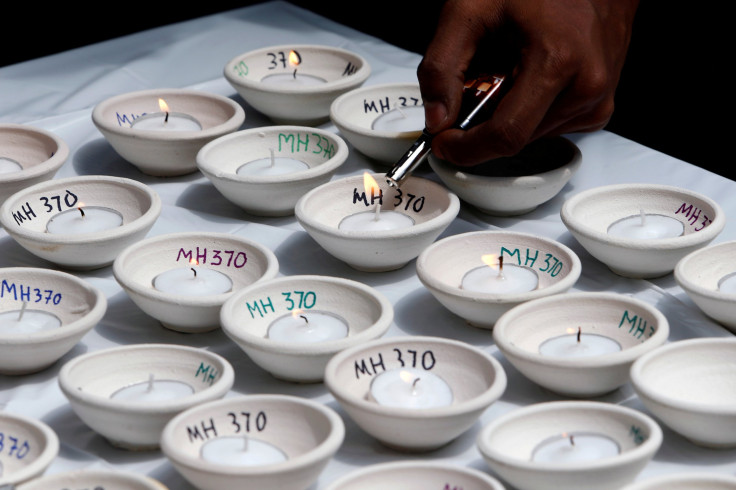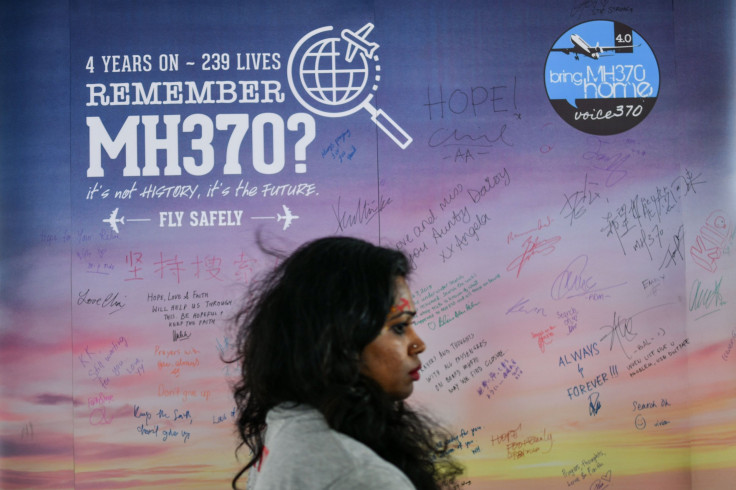MH370 Anniversary: Debris, Timeline And Everything Else We Know 5 Years Later

Friday marks the fifth year since Malaysia Airlines flight MH370 went missing with 239 people on board while traveling from Kuala Lumpur to Beijing. The plane lost contact with air traffic controllers March 8, 2014, and is believed to have crashed in a remote part of the southern Indian Ocean.
The plane took off at its scheduled time at 00:41 am local time and communicated as normal with air traffic control through about 01:07 am. The final transmission from MH370 was a man's voice, probably the pilot's, saying, "Goodnight Malaysian three seven zero." After the plane lost contact with the air traffic controller, a massive search operation was conducted to locate the it.
In three years, the search for MH370 became the costliest operation in aviation history. However, the three countries involved in the search -- Malaysia, China and Australia -- in an area of 46,332 square miles decided to call it off in 2017 after finding no concrete clues about the plane's whereabouts. It was also declared that those on board the jet were dead. Relatives of the missing have pushed for the search to continue until the plane is located, refusing to accept the government's assertion that their loved ones were dead.

Here's what we know so far about Flight MH370
- The Boeing 777-200's final transmission was a man's voice, probably the pilot's, saying, "Goodnight Malaysian three seven zero."
- The plane is believed to have crashed into the Indian Ocean and all passengers and crew on board are presumed dead.
- According to the manifest, there were 239 people on board the plane including 152 Chinese, 50 Malaysians, seven Indonesians, six Australians, five Indians, four French and three Americans. Two people were from Ukraine, two from Iran, two from New Zealand, two from Canada and one from the Netherlands, Hong Kong, Russia and Taiwan.
- The youngest passenger was Wang Moheng, who was 23 months old at the time.
- The plane's pilot was Zaharie Ahmad Shah, who had more than 18,000 hours of flying experience. His co-pilot, Fariq Abdul Hamid, had about 3,000 hours of experience.
- There were reports the plane lost significant altitude after it lost contact with ground controllers.
- A massive search operation was launched to locate the plane where it lost contact. The search was expanded after officials failed to find pings from the plane's black boxes.
- Despite the multimillion-dollar search, the plane was not found.
- The biggest lead in the investigation came when a flaperon (a part of the wing) was found by villagers on Réunion Island. Later, authorities confirmed the flaperon belonged to the missing jetliner.
- In the following months, several possible pieces of debris were found, with some said to be plane parts.
- Blaine Gibson, an independent wreckage hunter, found several pieces of debris, most of which were later said to be from the missing Malaysia Airlines plane.
- As of 2018, three items of debris were confirmed to be from MH370 — the right flaperon, a part of the right outboard flap and a section of the left outboard flap. Twenty-four other pieces of debris found were also believed to be from MH370. The items of debris were found as far north as the eastern coast of Tanzania and as far south as the eastern coast of South Africa.
- Despite several efforts the main wreckage of the plane is yet to be found and the mystery surrounding the jet's disappearance continues.
- Several conspiracy theories surfaced, with some saying the pilot deliberately crashed the plane while others hinted at a hijack. However, authorities have confirmed none of the theories.
- In 2017, the search operation for the plane was called off, a move that angered the families of those on board the jet.
- In January, 2018, Texas-based Ocean Infinity signed a "no cure, no fee" deal with the Malaysian government to find the jetliner. It scoured a 9,652 square-mile priority area in a remote part of the southern Indian Ocean but found no clue as to where the plane was.
- In July, 2018, Malaysia released a report stating that Flight MH370 deviated from its path "not because of anomalies in the mechanical system. The turn back was made not under autopilot but under manual control.” However, it added that a “third-party interference” couldn’t be ruled out.
- Last year, in August, Ian Wilson, a United Kingdom-based video producer, claimed to have spotted missing Malaysia Airlines Flight MH370 in a Cambodian jungle on Google Maps. He also planned a helicopter search of the area in October, which was later called off because of the difficult terrain.
- Private investigator Andre Milne — founder of military technology firm Unicorn Aerospace — hailed Wilson's theory as a "significant" finding and "clearly a match." However, there was no confirmed evidence to prove the claim that the fuselage of the plane was in the Cambodian jungles.
- In November, 2018, a retired United Airlines pilot claimed Flight MH370 caught fire before it crashed into a remote part of the southern Indian Ocean. Captain Ross Aimer said he believed the lithium-ion batteries in the cargo of the plane ignited shortly after the plane took off from Kuala Lumpur. This conspiracy theory has also not been confirmed.
- Other such claims include the plane being hijacked for organ harvesting, and it having been shot down.
- On March 3, Malaysian transport minister, Anthony Loke, said he was “willing” to restart the search if there were “specific proposals.” “We haven’t given up hope,” he said. “We hope we can continue the search in due course.”
- Earlier this week, Forbes reported that the airline industry has been fine-tuning technology to make sure that they can track airplanes at all times. In the next three years, major airlines will be using a satellite-based system that can help them track aircrafts anywhere in the world at all times.
© Copyright IBTimes 2024. All rights reserved.





















